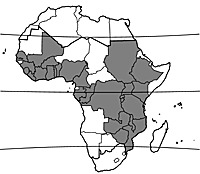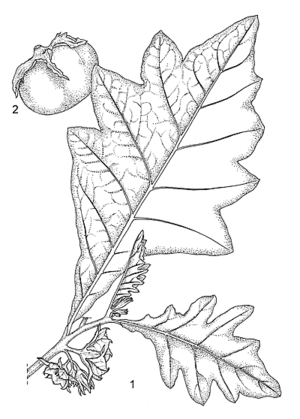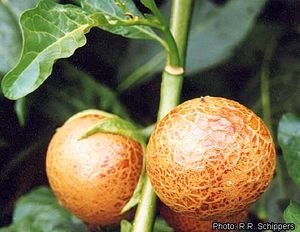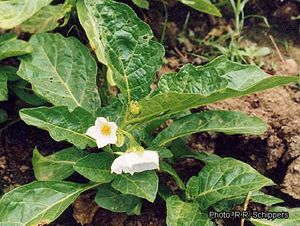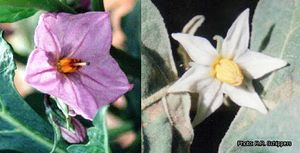Solanum macrocarpon (PROTA)
Introduction |
| General importance | |
| Geographic coverage Africa | |
| Geographic coverage World | |
| Fruit | |
| Vegetable | |
| Medicinal | |
| Ornamental | |
| Food security | |
- Protologue: Mant. pl. 2: 205 (1771).
- Family: Solanaceae
- Chromosome number: 2n = 24, 36
Synonyms
- Solanum dasyphyllum Schumach. & Thonn. (1827).
Vernacular names
- Gboma, gboma eggplant, African eggplant (En).
- Gboma, aubergine gboma, anghive, aubergine africaine (Fr).
- Berinjela africana, beringela africana (Po).
- Ngogwe, nyanya, nyanya chungu (Sw).
Origin and geographic distribution
The genus Solanum comprises over 1000 species worldwide. In Africa and adjacent islands it is represented by at least 100 indigenous species; about 20 of these are recent introductions. Solanum macrocarpon has an African ancestry. Spiny wild forms are found throughout the tropical non-arid parts of Africa, their fruits still being gathered occasionally as vegetable, whereas the cultivated forms, called ‘gboma’ in West Africa, constitute an important fruit and leaf vegetable, grown for the market and in home gardens. Local cultivars grown for the leaves are common throughout West and Central Africa, while the fruit types are mainly restricted to the humid coastal areas of West Africa. Gboma has been recorded in many West African countries and probably occurs in all coastal countries. It is also widespread in Central and East Africa. In southern Africa it has been recorded as a vegetable in Malawi, Zambia, Zimbabwe and Mozambique. Several fruit cultivars can also be found in South America (Suriname) and the Caribbean, apparently introduced from West Africa, the local name in Suriname being ‘ndrowa’ (’ndrowa’ is the name of certain types of Solanum aethiopicum L. in Côte d’Ivoire). It has been reported from Thailand and Indonesia, but this is probably erroneous and concerns a different species.
Uses
The young leaves and young fruits are cooked and consumed as a vegetable. The leaves are eaten as a separate dish or in sauces together with other ingredients. The taste is more or less bitter and very much liked. The leaves can either be steamed (as practised in Uganda) or fried in oil with onions. In West Africa both leaves and fruits are eaten. A popular cultivar in Benin is a small-fruited leaf type, whereas in Côte d’Ivoire a big-fruited type grown for its fruits is popular. In Uganda it is mostly the leaves that are eaten, but the fruits are added to sauces.
The leaves, fruits and roots have a variety of medicinal uses. In Sierra Leone heated leaves are chewed to treat throat troubles; in Nigeria fruits are taken as a laxative, and to treat cardiac diseases, while flowers and fruits are chewed to clean the teeth; in Kenya the juice of boiled roots is drunk to get rid of hookworms, while crushed leaves are taken to treat stomach troubles. Solanum macrocarpon is occasionally grown as an ornamental.
Production and international trade
Leaves and fruits of gboma are common market vegetables in many African countries, but statistics on production and trade are not available. There is some export of gboma fruits from Senegal and Uganda to European markets (Paris, Brussels). In the Caribbean (Santo Domingo) and Suriname gboma fruits are produced for export to the United States and Europe (Amsterdam).
Properties
The composition of gboma leaves is comparable to that of other dark green leaf vegetables, while the composition of gboma fruits is similar to that of eggplant (Solanum melongena L.). Gboma leaves contain per 100 g edible portion: water 85.6 g, energy 176 kJ (42 kcal), protein 4.6 g, fat 1.0 g, carbohydrate 6.4 g, fibre 1.6 g, Ca 391 mg, P 49 mg. Gboma fruits contain per edible portion of 100 g (i.e. product as purchased): water 89.0 g, energy 168 kJ (40 kcal), protein 1.4 g, fat 1.0 g, carbohydrate 8.0 g, fibre 1.5 g, Ca 13 mg (Leung, W.-T.W., Busson, F. & Jardin, C., 1968). All Solanum species contain spirosolane alkaloids, including solanine and solanidine. These are bitter tasting and potentially poisonous when consumed frequently.
The petroleum ether fraction of a Solanum macrocarpon fruit extract showed acaricidal activity against the tick Rhipicephalus appendiculatus.
Description
- Shrub or subshrub up to 1.5 m tall; stems terete, glabrous or with stellate hairs, not prickly or with straight, robust prickles up to 6 mm long.
- Leaves alternate, simple; stipules absent; petiole up to 7 cm long or leaves subsessile; blade 15–46 cm × 8–30 cm, entire or with short to large lobes up to 8 cm long, hairy on both surfaces with simple or stellate hairs, later often glabrescent, prickles present or absent on leaves, when present principally on midrib and lateral veins, straight, up to 13 mm long.
- Inflorescence lateral, racemose, 3–12-flowered.
- Flowers functionally female and larger in lower part of inflorescence, functionally male with short styles in upper part, regular, 5(–6)-merous, pedicellate; calyx campanulate, lobes pointed, hairy, glandular, sometimes prickly, often accrescent in fruit; corolla infundibuliform-rotate or campanulate, 2–3.5 cm long, pale purple or purple, rarely white, glandular hairy outside, glabrous inside; stamens alternate with corolla lobes, filaments short and thick, anthers connivent, opening by terminal pores; ovary superior, 2–5-celled, glabrous or slightly glandular hairy, style in female flowers slightly longer than stamens.
- Fruit a depressed globose berry 2–6 cm × 3–10 cm, green, ivory or purplish white with dark stripes when young, yellow to brownish when ripe, many-seeded, partly covered by the enlarged calyx lobes; fruit stalk erect or decurved, 1–4 cm long.
- Seeds compressed obovoid to reniform, 3–4.5 mm × 2–3.5 mm.
- Seedling with epigeal germination; cotyledons leafy, subsessile, narrowly elliptical.
Other botanical information
Solanum macrocarpon is extremely variable. It is treated here as including Solanum macrocarpon L. sensu stricto and Solanum dasyphyllum Schumach. & Thonn. (wild ancestor of Solanum macrocarpon). This is done because crossability experiments involving various groups of the Solanum macrocarpon complex, including wild Solanum dasyphyllum and semiwild types and cultivars, produced fully fertile F1 and F2 hybrids. F1 hybrids between the cultivars of Solanum macrocarpon and the wild group (Solanum dasyphyllum) showed normal meiosis. The domestication process of Solanum dasyphyllum has involved selection against hairs, prickles and deeply lobed leaves. Landraces that were selected for their fruit often show a reduction in bitterness and an increase in fruit size. The distinction between the leaf types and fruit types is not very strict because the leaves of the fruit group may also be eaten, but these are not as soft as the leafy types. The fruit types have larger (180–500 g) and softer fruits whereas the leaf types have relatively smaller fruits (<180 g), which are often rather hard and have a cracked surface.
Several cultivars of Solanum macrocarpon are cultivated e.g. in Ghana, where they are mainly grown for their fruit and less so for their leaves. The names given to these cultivars are either those under which they were known by farmers or named after the village where they were found. Fruits and leaves of ‘Gboma’, ‘Mankessim’, ‘Akwaseho’ and ‘Kade’ are consumed, whereas of ‘Sarpeiman’ and ‘Bui’ only fruits are eaten.
Growth and development
Gboma seeds are orthodox and if kept dry and cool will maintain a high viability for several years. However, if kept at room temperature and high air humidity, viability is lost in a few months. Germination starts about a week after sowing. Flowering starts 2–3 months after germination. Cultivars grown in savanna areas flower earlier than those in high-rainfall areas and are more tolerant to drought. The crop is mainly self-pollinated. It has low levels of out-crossing, which is mainly done by bees and other pollinating insects. Flowers open early in the morning when it is still dark. The stigma is receptive some hours before the flowers open and remains receptive for about two days. Fruits are ready for picking 3–4 weeks after fruit set. Fruits take about 10 weeks to ripen and seeds should be collected from fruits, which are physiologically ripe.
Ecology
Most leafy cultivars grow in high-rainfall areas of West and Central Africa. An exception is a group of cultivars with small leaves and fruits, found in the semi-arid and savanna areas of Northern Ghana, Burkina Faso and neighbouring countries. Fruit cultivars are restricted to the humid coastal areas from Côte d’Ivoire to Nigeria and also along the East African coast. Gboma requires warm conditions and is only occasionally found at high altitudes, e.g. in Cameroon. At high altitudes, plants are sturdy and their growth rate is slow.
Propagation and planting
The 1000-seed weight is about 1.7 g. Seeds are sown in a nursery and are spaced at 20 cm between the rows. Presoaking of seeds in hydrogen peroxide for 24 hours generally improves germination. Seedlings of leafy cultivars are transplanted after 4–6 weeks at a spacing of 50 cm × 50 cm. The spacing for fruit cultivars is about 1 m × 1 m. Fruit cultivars require more frequent watering than the leaf cultivars as drought causes seeds to develop faster making the fruits unsuitable for consumption. When preparing beds it is recommended that NPK 15-15-15 fertilizer be added at a rate of 80–100 kg/ha.
Management
Commercial growers normally practise monocropping. For subsistence cultivation, farmers grow their landraces in home gardens as a sole crop or intercropped with other food crops like maize and cassava. Gboma responds well to NPK fertilizer and animal manure. When the crop is grown for its leaves, it is trimmed when about 20 cm tall to promote the production of new shoots. Abundant fruit production also follows trimming.
Diseases and pests
Gboma is rather resistant to diseases and pests compared to exotic vegetables like tomatoes. Many diseases and pests have been reported to attack the crop, but most are rarely very harmful: Puccinia penniseti (yellow rust), Geotrichum candidum (rusty brown leaf spot), Fusarium sp., Rhizoctonia solani, Verticillium dahliae (wilt), Gloeosporium melongenae (anthracnose), Leveillula taurica (powdery mildew), Phomopsis vexans (phomopsis rot), Phytophthora parasitica (fruit rot), Ralstonia solanacearum (bacterial wilt), leaf curl virus, Empoasca flavescens (leaf hopper), Epilachna hirta (leaf beetle), Epitrix cucumeris and Epitrix parula (flea beetle), Heliothis armigera (army worm), Leucinodes orbonalis (fruit borer), Meloidogyne species (root-knot nematodes), Psylliodes balyi and Psylliodes splendida (cut worm), Jacobiasca lybica, Spodoptera littoralis (army worm), Prodenia litura, and Tetranychus truncates (red spider mite). Gboma leaves often show a deformation and a mottled viruslike appearance, caused by mites (Polyphagotersonemus latus); when the symptoms appear, the mites have already migrated to the younger leaves.
Certain cultivars are resistant to Cercospora solani, Thielaviopsis basicola (damping-off disease), Leucinodes orbonalis, Trialeurodes vaporariorum (whitefly), Amrasca biguttula (leaf hopper), and highly tolerant to Tetranychus urticae (spider mite) and Fusarium wilting. Cultivars having fruits with a tough calyx cover and high phenolic content are more resistant to fruit borers than those without. It was observed that gboma completely resisted shoot infestation of Leucinodes orbonalis, performing better than Solanum incanum L., which is well known for its resistance to this pest.
Harvesting
Leaf harvest starts 6–9 weeks after transplanting, usually about a week after flowers have appeared. The leaves are harvested periodically and depending on the availability of water the crop continues to produce for up to a year. The whole shoot with the terminal bud and occasionally the flowers is picked. Subsequent harvests are made every two weeks and consist of side shoots. Where fruits are eaten, they are picked when still unripe, 2–4 months after sowing. Ripe fruits are harvested one month later for seed.
Yield
An average leaf yield of 2.9 kg/m2 with a crop spacing of 50 cm × 50 cm has been recorded in Nigeria. Cultivars with early regrowth are most suitable for high yields as a leaf vegetable. Leaves can be harvested for several seasons from regrowths but a new crop gives the best yield. In Senegal the cultivar ‘Newubaar’ has given 1.5 kg of fruits per plant in 4 months. Regular leaf harvesting decreases the fruit yield.
Handling after harvest
Fresh leaves and fruits are easily transported and can be kept in good condition for some time, especially in shady or cool places. Sprinkling with water helps to keep the leaves fresh. Gboma leaves are sometimes preserved by sun-drying, but Aspergillus species and other storage fungi may develop on stored leaves. The dried product is broken into small pieces or ground to powder and used in soup. Fruit cultivars with a soft skin are preferred; they are easy to cook, but they do not travel well. Cultivars with a tough skin are easily transported and can be stored up to two weeks.
Genetic resources
Local landraces are presently not at great risk of genetic erosion. National research institutes in Nigeria and Ghana maintain germplasm of Solanum macrocarpon. Since 1980, the International Plant Genetic Resources Institute (IPGRI) has organized Solanum species collecting missions in West Africa (Benin, Burkina Faso, Côte d’Ivoire, Ghana and Togo) and materials have also been collected from many other African countries including Nigeria, Uganda and Zimbabwe. A collection was held at the University of Birmingham (United Kingdom). Recently this material has been transferred to the University of Nijmegen (Netherlands).
Breeding
In most African countries gboma is considered to be a minor crop, except in Nigeria, and therefore research to enhance the germplasm potential is scarce. Cultivar development work started in 1998 in both Cameroon and Ghana. The tremendous variability in the species, embracing the wild ancestor Solanum dasyphyllum, semiwild forms and cultivars from both humid and dry areas, offers a good opportunity to the breeder to improve the crop, e.g. for disease resistance.
F1 and F2 hybrids between the various groups of Solanum macrocarpon (including wild Solanum dasyphyllum) show heterosis and F2 superior hybrids have been isolated as candidates for future breeding programmes. Fertile interspecific crosses of Solanum macrocarpon with Solanum aethiopicum L. and Solanum melongena L. are possible. Solanum macrocarpon is a good genitor for inducing disease- and pest resistances in eggplant (Solanum melongena). In India, the resistance to fruit and shoot borer (Leucinodes orbonalis) is incorporated in eggplant by crossing.
Prospects
Gboma with its slightly bitter taste is liked by consumers. The high nutritive value of the leaves and the high leaf and fruit yield, as well as the fairly high resistance to pests and diseases make the crop interesting for development. The leafy cultivars have potential for introduction in semi-arid areas to improve the nutritional status of the population. The fruity cultivars have potential for promotion in hot humid areas. The considerable variation within the species gives it high potential for breeding for various purposes. Development of the export market will require uniform cultivars and putting in place a good system of post-harvest handling.
Major references
- Bonsu, K.O., Owusu, E.O., Nkansah, G.O. & Schippers, R.R., 1998. Preliminary characterization of Solanum macrocarpon germplasm from different ecological zones of Ghana. Workshop for Identification of Vegetable Research Priorities I Brong Ahafo Region of Ghana, 10–11 September 1998. Sunyani, Ghana. 7 pp.
- Bukenya-Ziraba, R., 1980. Studies in the taxonomy of Solanum L. in southern Ghana. MSc thesis. University of Ghana, Ghana. 194 pp.
- Bukenya-Ziraba, R., 1993. Studies in the taxonomy of genus Solanum in Uganda. PhD thesis. Makerere University, Kampala, Uganda. 456 pp.
- Bukenya-Ziraba, R. & Carasco, J.F., 1994. Biosytematic study of Solanum macrocarpon-Solanum dasyphyllum complex in Uganda and the relations with Solanum linnaeanum. East Africa Agricultural and Forestry Journal 59(3): 187–204.
- Bukenya-Ziraba, R. & Hall, J.B., 1987. Six cultivars of Solanum macrocarpon in Ghana. Bothalia 17(1): 91–95.
- Leung, W.-T.W., Busson, F. & Jardin, C., 1968. Food composition table for use in Africa. FAO, Rome, Italy. 306 pp.
- Schippers, R.R., 2000. African indigenous vegetables. An overview of the cultivated species. Natural Resources Institute/ACP-EU Technical Centre for Agricultural and Rural Cooperation, Chatham, United Kingdom. 214 pp.
- Stevels, J.M.C., 1990. Légumes traditionnels du Cameroun: une étude agrobotanique. Wageningen Agricultural University Papers 90–1. Wageningen Agricultural University, Wageningen, Netherlands. 262 pp.
Other references
- Bonsu, K.O., Fontem, D.A., Nkansah, G.O., Iroume, R.N., Owusu, E.O. & Schippers, R.R., 2002. Diversity within the Gboma eggplant (Solanum macrocarpon), an indigenous vegetable from West Africa. Ghana Journal of Horticulture 1: 50–58.
- Bonsu, K.O., Schippers, R.R., Nkansah G.O., Owusu E.O. & Orchard J.E., 2000. Gboma eggplant, a potential new export crop for Ghana. Book of Abstracts. Fifth International Solanaceae Conference, Botanical Garden of Nijmegen, July 23–29, 2000. 14 pp.
- Bukenya-Ziraba, R., 1994. Solanum macrocarpon: an under-utilised but potential vegetable in Uganda. In: Seyani J.H. & Chikuni A.C. (Editors). Proceedings 13th plenary meeting AETFAT, Malawi. Volume 1. pp. 17–24.
- Bukenya-Ziraba, R. & Carasco, J.F., 1995. Crossability and cytological studies in Solanum macrocarpon and Solanum linnaeanum (Solanacaeae). Euphytica 86: 5–13.
- Gangopadhyay, C., Maity, T.K. & Mandal, S.K., 1996. Screening of brinjal germplasms against fruit and shoot borer Leucinodes orbonalis. Environment and Ecology 14(4): 834–836.
- Jaeger, P.M.L. & Hepper, F.N., 1986. A review of the genus Solanum in Africa. In: D’Arcy, W.G. (Editor). Solanaceae: biology and systematics. Columbia University Press, New York, United States. pp. 41–55.
- Kumar, N.K.K. & Sadashiva, A.T., 1996. Solanum macrocarpon: a wild species of brinjal resistant to brinjal shoot and fruit borer, Leucinodes arbonalis (Guen.). Insect-Environment 2(2): 41–42.
- Lester, R.N., Jaeger, P.M.L., Bleijendaal-Spierings, B.H.M., Bleijendaal, H.P.O. & Holloway, H.L.O., 1990. African eggplants - a review of collecting in West Africa. Plant Genetic Resources Newsletter 81/82: 17–26.
- Ojo, D.O. & Olufolaji, A.O., 1997. Optimum NPK fertiliser rates for growth and yield of Solanum macrocarpon (cv. ‘Igdagba’). Journal of Vegetable Environment and Ecology 14(4): 834–836.
- Oladiran, J.A., 1989. The effects of fruit colour, processing technique and seed treatment on the germination of Solanum macrocarpon L. (Igbagba). Nigerian Journal of Technological Research 1(1): 17–20.
- Taylor, O.-O, Fetuga, B.L. & Oyenuga, V.A., 1983. Accumulation of mineral elements in five leafy vegetables as influenced by nitrogen fertilisation and age. Scientia Horticulturae 18(4): 313–322.
- Van Puyvelde, L., Geysen, D., Ayobangira, F.X., Hakizamungu, E., Nshimiyimana, A. & Kalisa, A., 1985. Screening of medicinal plants of Rwanda for acaricidal activity. Journal of Ethnopharmacology 13(2): 209–215.
Sources of illustration
- Stevels, J.M.C., 1990. Légumes traditionnels du Cameroun: une étude agrobotanique. Wageningen Agricultural University Papers 90–1. Wageningen Agricultural University, Wageningen, Netherlands. 262 pp.
Author(s)
- R. Bukenya-Ziraba, Department of Botany, Makerere University, P.O. Box 7062, Kampala, Uganda
- K.O. Bonsu, Horticulture Division, Crops Research Institute, P.O. Box 3785, Kumasi, Ghana
Correct citation of this article
Bukenya-Ziraba, R. & Bonsu, K.O., 2004. Solanum macrocarpon L. [Internet] Record from PROTA4U. Grubben, G.J.H. & Denton, O.A. (Editors). PROTA (Plant Resources of Tropical Africa / Ressources végétales de l’Afrique tropicale), Wageningen, Netherlands. <http://www.prota4u.org/search.asp>.
Accessed 6 March 2025.
- See the Prota4U database.

